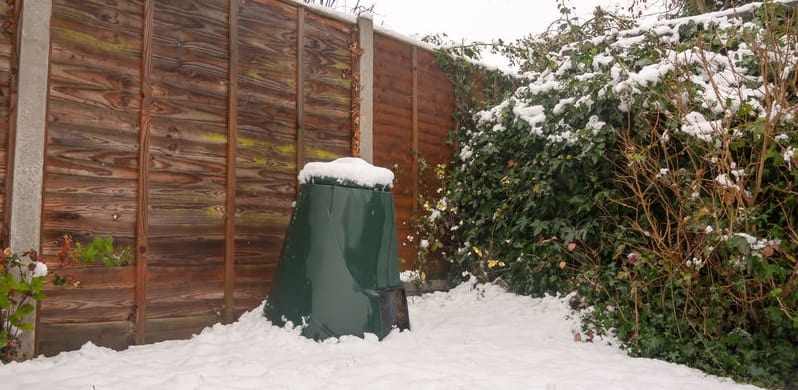If you are like me when I started composting, and like the hundreds of millions of people around the world who live in colder climates, you may be wondering if you can compost in the winter?
Well, let me assure you that yes, you most definitely can compost in the winter. And, if you do it right, you will have a great head start with an amazing batch of compost ready for the Spring gardening season.
Generally speaking, composting In the winter really isn’t much different than composting any other time of the year. The only real difference is the fact that, like everything else in a cold climate, the microbes will slow down and even stop if the right steps were not taken to prepare the compost before the bad weather came in.
Below, we will look at the process involved to produce great compost during the winter months.
What is Composting in the Winter?
Now the real goal to composting during the winter months is to keep an active compost pile. This means keeping a pile that the microbial activity in the center does not cease and continues to break down the raw material while the outside air is below freezing.
In any hot compost pile, the goal, no matter what time of year, is to have an internal temperature of 120 to 170 degrees Fahrenheit or 49 to 77 degrees Celsius.
It is at these temperatures that the fast breakdown of raw ingredients like leaves, grass clippings, and kitchen scraps really take place and that unwanted things like weed seeds are killed off.
For successful winter composting, these temperatures must be kept up in the center of the pile. Following some simple steps before the snow starts to fly will ensure a successful batch of compost come the springtime.
What are the steps involved?
Creating great compost in the winter is easy and virtually no effort throughout the entire process. With a little work in the beginning and a tiny bit of “maintenance” throughout the snowy times, you will have fantastic compost ready for spring planting.
- Since the goal of winter composting is having an active, hot compost pile with lots of microbes eagerly eating away at your raw materials, the first step is to have the largest pile you can.
The reason for this is twofold. You want a large pile of materials because the center is where the action is going to happen, and the outer edges will still be exposed to the elements. Therefore, having a thick buffer on the outside will allow the middle section breakdown without fear of freezing. The second reason to have a large pile is that since you will not be turning the pile over for several months, you want to be able to have enough material in the pile to generate lots of compost for the Spring. More material in the Fall equals more fantastic compost in the Spring!A good goal for the size of your winter compost pile would be approx. four to five feet wide by about three to four feet tall. That’s a lot of compost I know but this size will work great. - Every good compost pile, no matter the season needs three things to be successful. Nitrogen (the green stuff like grass clippings and kitchen scraps), Carbon (this is the brown stuff, dry leaves, shredded paper etc), and moisture to help keep things moving.
During the warm Summer months you can usually get away with throwing these items into your pile without much concern but with a winter compost pile, you need to take one additional step.
First off, all your materials need to be brought down to a small size. We’re looking for something like a quarter to half inch pieces if possible. The small size makes it easier for the microbes to break the material down quicker and also allows for a better mix of green and brown material throughout your pile.
Just cut up your kitchen scraps a little more before and throwing them into the pile and for leaves and other garden material, a lawnmower makes a great shredder. Just pour everything out onto the lawn and run it over a couple of times. This is how I usually do it. - Choosing the type of compost container you want to use is up to you. Virtually anything will work, from a simple pile in the back of the yard to one constructed of old skids or pallets to a commercially purchased one with all the bells and whistles (really just a fancy lid and removable sides).
For winter compost, however, I would choose either the simple pile or one that you make yourself. And like I mentioned earlier, the reason for this is that you can control the size and, in this case, bigger is better.If you choose to build a composter with sides such as one made of old pallets or a more permanent one with solid posts and removable panels, you will have a slight advantage over the simple pile method. The sides of your bin will help act as a slight barrier to the outside elements and insulate the pile ever so slightly. Adding several inches of straw, hay or other fibrous material along the sides and top of the pile will also aid in insulating the pile. I have found that covering the entire pile and sides in this style of composter with a previous batch of finished compost works very well and will help in breaking down the inner material even better.If constructing a wooded one isn’t of interest to you, building a simple circular cage style composter out of chicken wire or similar material may be more of your liking. This style will help keep the pile tight a taller than building a simple compost heap.Choosing to use the simple pile method will work wonderfully as well so don’t feel that you must build a container to winter compost, the pile will work just fine as long as you follow the next steps. - Now you can start adding your materials. If you are planning to use straw or another insulating material on the sides of your pile you should add that first, building a ring around the outer edges of the inside of the bin. Work your way up along the sides a foot or so at a time, adding the well-mixed browns and greens as you go. This method will help keep the sides stable as you add material.
Add water as you go too. Just spray a good amount on every foot or so as well and this should do just fine. The material doesn’t need to be soaking wet but more like the consistency of a damp sponge. Too wet or too dry and the microbes may not activate properly.
Another trick to getting a little more activity to your pile during the winter is to add a layer of already finished compost every foot or so or if you desire, mix some in throughout all the materials. This will especially help bulk up the size of your compost pile if you are a bit worried that there may not be sufficient material to get the size of the pile big enough.
Continue these steps until you have used up your materials or that your pile is to your liking. - Once you have reached the top, no matter what the style of composter you are using, you want to cover the top with a thick dark-colored tarp or plastic. This is important because dark colors absorb the sunlight multiple times better than light plastic or nothing at all. As the sun hits the plastic daily, it will help keep the outer parts of the pile warmer and allow the microbial activity to venture further out from the inner parts. In turn, this will give you more finished compost in the Spring.
If you are using the simple pile method you will need to cover the entire compost heap with a large tarp or plastic to get the full effect of the sun and not allow cold wind to blow through the pile. Use blocks of wood or bricks to help hold the edges down so it does not blow away. Remember, the darker the tarp the better.And now you wait. This is where you let mother nature do her job. In the Spring you will have lots more compost to add to your garden.
Do you have to look after a compost pile in the winter?
There are a couple of things you can do to help your compost pile along during the cold winter months.
First off, just keep an eye on the pile itself to make sure the tarp is securely on and that animals haven’t been making it their home for the winter, after all, it does seem to be a nice warm spot to stay.
After any major snowfall, it’s always a good idea to go out and brush off any so that has accumulated on top of the pile. This will help the sun’s rays reach the dark plastic and warm the pile.
Add more compost. If you have more kitchen scraps, paper or other organic materials that you want to compost. You can add it to your pile. The build piles with the plastic on top are going to be the easier ones to do this with because you will simply just have to lift off the top and place the materials inside where the compost heap will have to have a large portion of the tarp covering it pulled up to get at it.
I don’t recommend pulling all the materials of the compost pile apart to get at the middle. Just place the contents on top and put the cover back over it. These items may freeze and not have much microbial activity through the winter, you will at least have a start to compost.
What to do with your compost pile in the Spring?
After the final snows have finished and the Spring flowers are poking their sleepy heads through the warm soil, it’s time to open up that pile and see what has happened over the winter.
If everything has gone as planned, you should have great, finished compost in the center to bottom of your pile. By now it should have a nice earthy smell and be very dark in color.
Separate all the good stuff from the materials that did not compost through the winter. Here you can now mix in the materials you used for the insulator like the stray or hay into a new batch of compost for later in the season.
I hope you are able to take some of these steps and create some great winter compost for your garden. It’s worth the effort.
On a side note, if you have an existing compost pile that you use during the warmer months that you would like to continue to use through the winter, all you need to do is follow the steps from above. Instead of worrying about having small pieces to break down, all you will have to do is mix your pile thoroughly beforehand.

